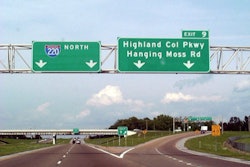 The Statewide Transportation Operations Center of the NCDOT kept drivers alerted to dangerous road conditions after Hurricane Florence, such as this washout on N.C. 210 in Bladen County. Photo: N.C. Department of Transportation
The Statewide Transportation Operations Center of the NCDOT kept drivers alerted to dangerous road conditions after Hurricane Florence, such as this washout on N.C. 210 in Bladen County. Photo: N.C. Department of TransportationWith devastating forecasts looming for North Carolina as Hurricane Florence spun closer, the Statewide Transportation Operations Center coordinated plans for an evacuation of much of the state’s eastern coast.
A national award credits the center, part of the N.C. Department of Transportation, with successfully deploying those plans, which kept average speeds at 50 mph as thousands of residents and vacationers fled to safer areas.
For the evacuation and other efforts before and after the hurricane, the center was recently named the winner of a Transportation Systems Management and Operations (TSMO) Award for “major incident or special event planning and response.” The award is presented by the National Operations Center of Excellence.
The award also cited the center’s coordination of the use of drones to determine which roads were safe to travel after the hurricane caused massive flooding through large sections of the state. The center also provided regular online updates as road conditions changed.
“The award recognizes an agency’s response to an incident using tools that maximize roadway efficiency and safety through management and operational ingenuity,” according to an NCDOT news release. “The award also recognizes interagency cooperation and other measures that improved safety, and travel time or congestion issues.”
The center spearheaded a plan that led to optimal traffic flow from the coast and was prepared to implement creative solutions if average highway speeds dropped, the release said.
Center staff also coordinated drone programs with the State Highway Patrol, N.C. National Guard and local emergency personnel, according to the release. The drone footage was used to notify emergency officials and the public of safe routes. Florence’s wind and rain had closed more than 2,400 roads in the state, with as many as 1,600 closed at one time. Interstates 40 and 95 were closed for several days.
The center also fielded more than 27,000 calls from the public about the storm’s effects on roads and kept its online driver public information system, DriveNC.gov, frequently updated to let the public know which roads were closed.










